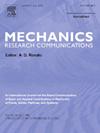Vibration analysis of functionally graded nanobeam in thermal environment
IF 2.3
4区 工程技术
Q3 MECHANICS
引用次数: 0
Abstract
Functionally graded (FG) nanobeams, as a key application of functionally graded materials (FGMs), demonstrate unique thermomechanical properties that make them particularly suitable for Micro-electromechanical Systems (MEMS) and other nanoscale applications. This study presents an analytical approach for investigating their vibration characteristics under linear and nonlinear temperature fields. The model integrates Euler–Bernoulli beam theory with nonlocal elasticity theory, thereby simultaneously capturing material gradation effects and size-dependent phenomena. A novel analytical framework is developed by applying the transfer function method (TFM) for the first time to the nonlocal Euler–Bernoulli beam model, enabling efficient analytical solution for natural frequencies. Unlike traditional numerical methods, the proposed method enhances computational efficiency and allows unified treatment of various boundary conditions. Numerical studies are conducted to comprehensively evaluate the effects of environment fields, constituent volume distribution, slenderness ratio, nonlocal parameters, and boundary conditions on the vibration behavior of FG nanobeams. The results offer valuable insights for the design and optimization of MEMS devices, thermally stressed aerospace components, and microscale biomedical structures operating in complex thermal environments.
热环境下功能梯度纳米梁的振动分析
功能梯度(FG)纳米梁作为功能梯度材料(fgm)的关键应用,具有独特的热机械性能,使其特别适用于微机电系统(MEMS)和其他纳米级应用。本文提出了一种分析方法来研究它们在线性和非线性温度场下的振动特性。该模型将欧拉-伯努利梁理论与非局部弹性理论相结合,同时捕捉了材料的级配效应和尺寸依赖现象。将传递函数法(TFM)首次应用于非局部欧拉-伯努利梁模型,建立了一种新的解析框架,实现了固有频率的高效解析解。与传统的数值方法不同,该方法提高了计算效率,并可以统一处理各种边界条件。通过数值研究综合评价了环境场、组分体积分布、长细比、非局部参数和边界条件对FG纳米梁振动行为的影响。研究结果为MEMS器件、热应力航空航天元件和在复杂热环境下运行的微尺度生物医学结构的设计和优化提供了有价值的见解。
本文章由计算机程序翻译,如有差异,请以英文原文为准。
求助全文
约1分钟内获得全文
求助全文
来源期刊
CiteScore
4.10
自引率
4.20%
发文量
114
审稿时长
9 months
期刊介绍:
Mechanics Research Communications publishes, as rapidly as possible, peer-reviewed manuscripts of high standards but restricted length. It aims to provide:
• a fast means of communication
• an exchange of ideas among workers in mechanics
• an effective method of bringing new results quickly to the public
• an informal vehicle for the discussion
• of ideas that may still be in the formative stages
The field of Mechanics will be understood to encompass the behavior of continua, fluids, solids, particles and their mixtures. Submissions must contain a strong, novel contribution to the field of mechanics, and ideally should be focused on current issues in the field involving theoretical, experimental and/or applied research, preferably within the broad expertise encompassed by the Board of Associate Editors. Deviations from these areas should be discussed in advance with the Editor-in-Chief.

 求助内容:
求助内容: 应助结果提醒方式:
应助结果提醒方式:


